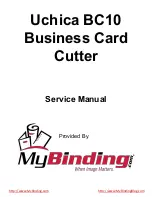
22
d) Product
• Using the product for purposes it was not intended for can results in hazards and injuries.
•
Use only accessories designed specifically for this tool. Accessories that fit but are not approved or
recommended by the manufacturer can cause hazards.
• Do not use damaged cutting heads. Before use, inspect the product for damage such as chipping,
cracks, excessive wear and loose parts. If the tool is dropped, the blades must also be checked. Allow
the appliance to idle for about 30 seconds. Do not stand or allow other people to stand nearby.
• After switching the product off, wait for the blades to come to a complete stop before putting it down. The
blades could have contact with a surface and move in an uncontrolled manner.
• Switch the power off when carrying. It can have contact with clothing and cause injury.
• WARNING: Keep hands far from the working area and the blades. Keep the second hand on the auxiliary
hand grip, or on the motor case. If both hands are holding the tool, they cannot be cut by the blades.
• Before attaching or removing cutting heads, the battery must be removed from the appliance. Mainte-
nance must be performed safely to prevent accidents caused by an unexpected start.
• Do not overload the tool. Only use tools for their intended purpose. A suitable tool does the job better
and, more importantly, more safely.
• Check the on/off switch before each use. Using the tool with a damaged on/off switch hinders control of
the tool and is therefore very dangerous.
•
Prevent unintentional switching on of the tool. Do not carry the tool with your finger on the on/off switch.
• Always remove the battery before adjusting or storing the appliance or changing attachments/acces-
sories. This prevents you from turning the appliance on by accident.
• Service the tool regularly and check for signs of damage, dirt, incorrect settings, wear and tear or other
issues that may present a hazard. Have damaged appliances repaired by a specialist before use. Poorly
maintained tools often lead to accidents.
• Never attempt to switch off safety mechanisms.
• Switch the product off immediately if there is a blockage.
• Keep the handles and surfaces of the tool dry, clean and free of oil or lubricants. Slipping during opera-
tion leads to a loss of control and accidents.
• It is prohibited to remove or bridge any of the switching elements installed on the tool by the manufac-
turer (e.g. by securing a button to the handle) as this would prevent the tool from switching off automati-
cally and result in high risk of injury.
•
Never use the product with a telescopic/long handle fitted.
















































